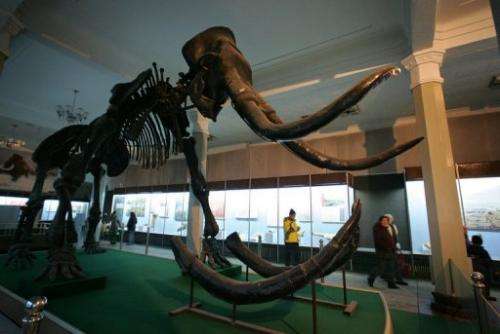New study points finger at climate in mammoth's demise

A wide-ranging probe into woolly mammoths has added to evidence that the towering tusker was wiped out by climate change, scientists said on Wednesday.
British and Swedish researchers sequenced DNA from 88 samples of mammoth bone, tooth and tusk, looking for a signature in the genetic code that is handed down on the maternal line.
They used this telltale to build a family tree of mammoths spanning 200,000 years, across northern Eurasia and North America.
They found two periods of big population shakeup, both of them occurring in "interglacials," or periods between ice ages.
A warm period 120,000 years ago caused populations to decline and become fragmented, leading to the emergence of a distinct type of mammoth that lived in western Europe.
The cold then returned, for a period lasting around 100,000 years called the Late Pleistocene—the last ice age until now.
Superbly adapted to the cold, arid steppe and tundra, mammoths were the kings of the north.
They ruled from western Europe to the northern part of North America, which could be reached from Eurasia by an ice bridge across the Bering Strait.
Then as the temperatures gradually rose once more, the populations shifted again and the mammoths were again confined to small pockets of favourable habitat.
What happened next is the final chapter in the great mammoth mystery.
Other researchers have similarly concluded that climate change drove the mammoth to the brink but say it was hunting by humans that delivered the final blow.
But this argument has a flaw.
Humans could hardly be to blame if mammoths were able—as in previous interglacials—to hole up in some chilly redoubt that was too remote for habitation or hunting.
"Spells of warm climate made the mammoth more susceptible to extinction," said Love Dalen at the Swedish Museum of Natural History.
But to understand why the entire species became extinct, further investigations are needed in the final places where mammoths survived, said Dalen.
Two good candidate locations are St. Paul, an island off Alaska, and Wrangel, an island in the Siberian Arctic, said co-researcher Ian Barnes at London's Royal Holloway University.
Wrangel Island, in the Siberian Arctic, and the island of St. Paul, off Alaska, are believed to have been the mammoths' last refuge.
Populations there may have survived as recently as 6,000 years ago, some 5,000 years later than counterparts on the mainland.
The study appears in Proceedings of the Royal Society B, published by Britain's de-facto Academy of Sciences.
More information: Holarctic genetic structure and range dynamics in the woolly mammoth: rspb.royalsocietypublishing.or … .1098/rspb.2013.1910
Journal information: Proceedings of the Royal Society B
© 2013 AFP




















